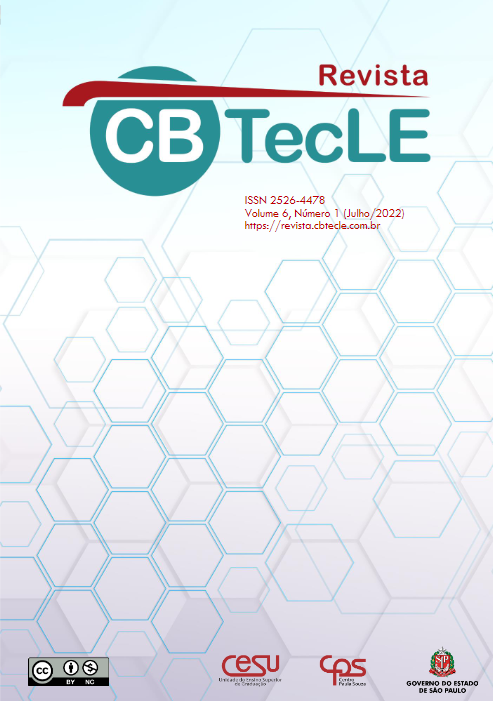THE PRODUCTION OF AUDIOVISUAL MATERIAL AS A MOTIVATING ELEMENT FOR THE PRACTICE OF SPEAKING IN ENGLISH LANGUAGE CLASSES: PROTAGONISM, MOTIVATION AND POSITIVE FEEDBACK
Keywords:
produção de vídeo, motivação;, Escola Publica, oralidade, protagonismoAbstract
This work aims at discussing how the production of videos in English language can be a motivational element for the practice of speaking in public high schools. It will also be discussed to what extent lowering the affective filter, through the production of videos by pairs in a safe environment, can allow for better flow in oral activities. We will see how the students, born in the digital era, can assist their teachers by bringing knowledge of digital media to the classroom and producing videos, which in turn favour autonomy and protagonist during class. In addition, the importance of positive feedback and self-diagnosis, as well as motivating them to keep moving forward will be discussed. At last, results from an experience carried out with ninth grade students (EF2) and third grade students (EM) will be reported.
References
REFERÊNCIAS BIBLIOGRÁFICAS:
BROWN, H.D. 1994. Teaching by Principles: an interactive approach to
language pedagogy. Englewood Cliffs, NJ: Prentice HalI Regents.
CALLEGARI, M. O. V. 2004. Saborear para saber: diferentes olhares sobre a
motivação em sala de aula - um estudo com alunos e professores de espanhol do ensino
médio. Tese de Mestrado em Educação, Universidade de São Paulo, São Paulo. DOI:
https://doi.org/10.11606/D.48.2004.de-16102008-181412. Disponível em:
https://www.teses.usp.br/teses/disponiveis/48/48134/tde-16102008-181412/pt-br.php.
Acesso em: 18 jun. 2020.
__________ 2006. Reflexões sobre o modelo de aquisição de segundas línguas de
Stephen Krashen: uma ponte entre a teoria e a prática em sala de aula. Trab.
linguist. apl., Campinas , v. 45, n. 1, p. 87-101, jun. 2006 . DOI:
https://doi.org/10.1590/S0103-18132006000100006. Disponível em:
http://www.scielo.br/scielo.php?script=sci_arttext&pid=S0103-18132006000100006&l
ng=pt&nrm=iso. acessos em 28 set. 2019..
__________ 2008. Motivação, ensino e aprendizagem de espanhol: caminhos possíveis.
Análise e intervenção Motivação, ensino e aprendizagem de espanhol: caminhos
possíveis. Análise e intervenção. Tese de Doutorado em Educação, Universidade de São
Paulo, São Paulo. DOI: https://doi.org/10.11606/T.48.2008.tde-18032009-154414.
Disponível em:
https://teses.usp.br/teses/disponiveis/48/48134/tde-18032009-154414/pt-br.php.
Acessado em 25 out.2019
COELHO, P. M. F. 2012. Os nativos digitais e as novas competências tecnológicas.
Texto Livre: Linguagem e Tecnologia, Belo Horizonte-MG, v. 5, n. 2, p. 88–95, DOI:
https://doi.org/10.17851/1983-3652.5.2.88-95. Disponível em:
https://periodicos.ufmg.br/index.php/textolivre/article/view/16621. Acesso em: 08 maio
HARMER, J. 2015. The practice of English Language Teaching. London: Pearson
Education United.
KRASHEN, S. 1985. The input hypothesis: Issues and implications. London: Longman.
MALHEIROS, R.; LIMA, R. L.; MARIANI, R. 2016. Videoprocesso : Ferramenta de
Equidade no Ensino. Journal of Research in Special Educational Needs, Volume 16
Number s1, p. 1085-1089. https://doi.org/10.1111/1471-3802.12253. Disponível em:
https://nasenjournals.onlinelibrary.wiley.com/doi/pdf/10.1111/1471-3802.12253. Acesso
em: 15 out. 2020.
MARTINS, T.; PESSOA, T. 2015. O Prazer em estar na Escola: A Gala de Cinema na
Aula. Revista de Estudios e Investigación en Psicologia y Educación. n.13. P. 168-171
DOI: https://doi.org/10.17979/reipe.2015.0.13.514. Disponível em:
https://pdfs.semanticscholar.org/8ba3/eebb8e454e30dd9e1fc925db9cccab8c0009.pdf?_
ga=2.198793071.1735825639.1605145145-1278289532.1605145145. Acesso em: 08
maio 2020.
MORÁN, J. M. 1995. O vídeo na sala de aula. Comunicação & Educação, [S. l.], n. 2,
p. 27-35. https://doi.org/10.11606/issn.2316-9125.v0i2p27-35 . Disponível em:
https://www.revistas.usp.br/comueduc/article/view/36131. Acesso em: 27 jul. 2020.
__________ 2007. Desafios na Comunicação Pessoal. São Paulo: Paulinas. Disponível
em:http://www.eca.usp.br/prof/moran/site/textos/tecnologias_eduacacao/midias_educ.p
df Acesso em: 25 nov. 2020.
__________ 2009. Vídeos são instrumentos de comunicação e de produção. Portal do
Professor. Edição 15. Disponível em:
http://portaldoprofessor.mec.gov.br/conteudoJornal.html?idConteudo=384. Acesso em :
jul.2020.
PRENSKY.M. 2001. Digital Natives, Digital Immigrants Part 1”. On the Horizon
Vol. 9, No. 5, pp.1 -6. DOI: https://doi.org/10.1108/10748120110424816 Disponivel
em:
https://www.emerald.com/insight/content/doi/10.1108/10748120110424816/full/html
Acesso em: 14 abr. 2020.
RICHARDS, J., & RODGERS, T. 2001. Approaches and Methods in Language
Teaching Cambridge: Cambridge University Press.
doi:https://doi.org/10.1017/CBO9780511667305.019 Disponivel em:
https://www.cambridge.org/core/books/approaches-and-methods-in-language-teaching/n
atural-approach/2DDAFD72A695D067449AF7F61F5F8C87 Acesso em 13 fev. 2020.



